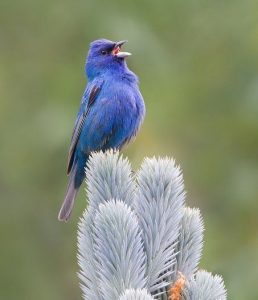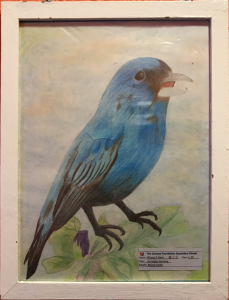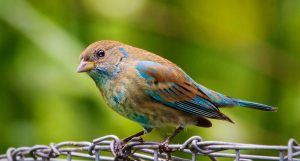| Common Name | (in English) Indigo Bunting Bird |
| (in Chinese) 靛藍彩鵐 | |
| Scientific Name | (in Latin) Passerina cyanea |
| Peculiar characteristics / external features: | A breeding male Indigo Bunting is blue all over, with slightly richer blue on his head and a shiny, silver-gray bill. Females are brown, with faint streaking on the breast, a whitish throat, and sometimes a touch of blue on the wings, tail, or rump. Immature males are patchy blue and brown. The immature bird resembles the female in coloring, although a male may have hints of blue on the tail and shoulders and have darker streaks on the underside.
The beak is short and conical. In the adult female, the beak is light brown tinged with blue, and in the adult male the upper half is brownish-black while the lower is light blue. The feet and legs are black or gray. |
| Distributions: | It is migratory, ranging from southern Canada to northern Florida during the breeding season, and from southern Florida to northern South America during the winter. |
| Habits: | |
| Dietary | The indigo bunting forages for food on the ground or in trees or shrubs. In winter, it often feeds in flocks with other indigo buntings, but is a solitary feeder during the breeding season. During the breeding season, the species eats insects, seeds and berries, including caterpillars, grasshoppers, spiders, beetles, and grass seeds. The seeds of grasses are the mainstay of its diet during the winter, although buds and insects are eaten when available. |
| Reproductive (Solitary/Social/Territorial, Courtship Behavior, Taking care of youngs, etc) | These birds are generally monogamous but not always faithful to their partner. In the western part of their range, they often hybridize with the lazuli bunting. Nesting sites are located in dense shrub or a low tree. The nest is made of leaves, coarse grasses, stems, and strips of bark, lined with soft grass or deer hair and is bound with spider web. It is constructed by the female, who cares for the eggs alone. The clutch consists of one to four eggs, but usually contains three to four. The eggs are white and usually unmarked, though some may be marked with brownish spots. Most pairs raise two broods per year, and the male may feed newly fledged young while the females incubate the next clutch of eggs. |
| Whatever appropriate | It often migrates by night, using the stars to navigate. The indigo bunting communicates through vocalizations and visual cues. A sharp chip! call is used by both sexes, and is used as an alarm call if a nest or chick is threatened. A high-pitched, buzzed zeeep is used as a contact call when the indigo bunting is in flight. The song of the male bird is a high-pitched buzzed sweet-sweet chew-chew sweet-sweet, lasting two to four seconds, sung to mark his territory to other males and to attract females. |
| Interesting Fact: | The brown-headed cowbird may parasitize this species. Indigo buntings abandon their nest if a cowbird egg appears before they lay eggs, but accept the egg after that point. Pairs with parasitized nests have less reproductive success. The bunting chicks hatch, but have lower survival rates as they must compete with the cowbird chick for food. |
References:
https://www.arkive.org/indigo-bunting/passerina-cyanea/
https://twitter.com/worldbirds38/status/934707306633269249
http://www.mendosa.com/fitnessblog/?p=10774
Voice of Indigo Bunting Bird
https://www.allaboutbirds.org/guide/Indigo_Bunting/id




